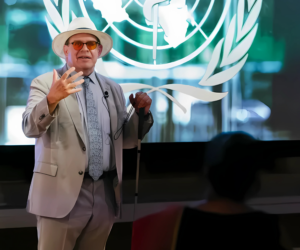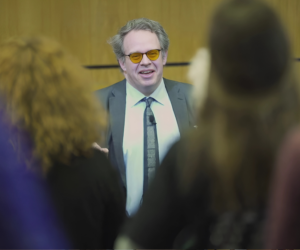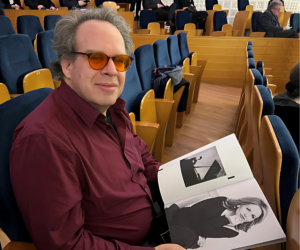WHO’s Christopher Bailey on the Healing Power of Creativity
We’ve long been told that laughter is the best medicine—but what if healing could also come through a paintbrush, a piano or a performance?
 A growing body of research suggests that arts-based interventions are powerful tools in treating a wide range of health conditions—from postpartum depression and chronic pain to anxiety and trauma. At the forefront of this intersection between creativity and clinical care is Christopher Bailey, a former stage actor from Iowa who now leads a global initiative within the World Health Organization (WHO) focused on integrating the arts into health systems around the world.
A growing body of research suggests that arts-based interventions are powerful tools in treating a wide range of health conditions—from postpartum depression and chronic pain to anxiety and trauma. At the forefront of this intersection between creativity and clinical care is Christopher Bailey, a former stage actor from Iowa who now leads a global initiative within the World Health Organization (WHO) focused on integrating the arts into health systems around the world.
Since 2019, Bailey has headed up the WHO’s arts and health program, championing policies, programs and research that recognize the arts not just as a form of expression, but as a vital part of wellbeing and recovery. In a recent conversation, he shared how the movement is gaining traction—particularly in the United States.
“Let’s try something different”
Bailey didn’t set out to become a global advocate for arts in health. In fact, he began his WHO journey in 2012 as the organization’s health informatics coordinator, a role rooted in data and digital strategy. But during his time working in African communities, he began to see the transformative power of the arts in action.
 “As the coordinator of online communications for the WHO, I had opportunities to use theater techniques as a form of community engagement,” Bailey said. “I saw how that revolutionized clinical work in Africa.”
“As the coordinator of online communications for the WHO, I had opportunities to use theater techniques as a form of community engagement,” Bailey said. “I saw how that revolutionized clinical work in Africa.”
He was also running an expat theater company in Geneva, using performance to initiate conversations around tough social issues. “We folded health and development themes into plays,” he recalled. “It was clear it was sparking positive community conversations that had never happened before on topics like intergenerational trauma and suicide prevention.”
The potential was undeniable, so Bailey proposed a more formal exploration of this work to the WHO Director-General. “I wanted to do a deep dive into the research and connect with the health professionals who have been utilizing arts to improve health,” he said. “He agreed.”
“When we remember the WHO definition of health, which states that health is more than merely the absence of disease and infirmity, but the attainment of the highest level of physical, mental and social well-being, then the value of the arts becomes apparent.”
Building a Global Body of Evidence
Given the WHO’s scientific focus, Bailey set out to ensure the arts and health program had a robust research foundation.
“I co-created the Jameel Arts and Health Lab with New York University and an NGO called Culturunners,” he explained. “It’s a consortium of research centers around the world that look at rigorous studies of artistic interventions designed to improve health in a physical, mental or social aspect.”
The Lab also explores what Bailey calls “the basic science” behind the healing power of the arts. “What is the neurology and biochemistry happening under the hood and the mechanism of art as a health benefit?”
In the U.S., the initiative works closely with leading research institutions, including NYU’s Creative Arts Therapies Consortium, Johns Hopkins University’s International Arts + Mind Center for A Neuroaesthetics and the University of Florida’s EpiArts Lab.
A Turning Point in 2019
One of the program’s biggest milestones came with the release of the WHO’s first global report on the evidence base for arts in health.
“The publication of that report had a lightning rod effect on the sector,” Bailey said. “It changed the space all over the world, including the U.S. People started taking it more seriously.”
Since then, momentum has grown. “We now have healthcare providers and lawmakers in communities and states—like Arkansas, Georgia, Massachusetts and New York—talking about ways to implement a ‘social prescribing’ framework that includes the healing arts in public health.”
From the Lincoln Center to Local Clinics
The program’s influence isn’t limited to research labs. Bailey highlighted several initiatives across the U.S. that are putting these ideas into action.
“We’ve collaborated with a national arts and health initiative called One Nation, One Project that supported local artists working with community health leaders in 15 states and the District of Columbia,” he said. “We’ve had healing arts conferences in Atlanta with WHO Goodwill Ambassador and opera singer Renée Fleming and Georgia State Representative Kim Schofield.”
 He also pointed to a panel at New York City’s Lincoln Center focused on art and wellbeing, and legislative progress in several states. “Right now, New York state’s legislature is considering a bill that would enable Medicaid to cover the services of creative art therapists,” he noted. “Four states—Arizona, California, New Mexico and Oregon—already have Medicaid reimbursement for healing practices like music therapy and dancing to help with physical and mental health.” These therapies have already demonstrated positive early outcomes in patients with Alzheimer’s and forms of dementia.
He also pointed to a panel at New York City’s Lincoln Center focused on art and wellbeing, and legislative progress in several states. “Right now, New York state’s legislature is considering a bill that would enable Medicaid to cover the services of creative art therapists,” he noted. “Four states—Arizona, California, New Mexico and Oregon—already have Medicaid reimbursement for healing practices like music therapy and dancing to help with physical and mental health.” These therapies have already demonstrated positive early outcomes in patients with Alzheimer’s and forms of dementia.
Art as Personal Medicine
Bailey’s passion for the work is also deeply personal. “I was diagnosed with cancer many years ago and was sick from chemotherapy,” he shared. “To get through it, I wrote a play. When I was on stage, I felt this profound sense of wellness. Maybe it was the analgesic effect or a distraction or focus, but it gave a negative experience an authentic personal meaning that helped with my physical recovery.”
Bailey says his journey into arts and health has been less about “big moments” than about quiet, continuous evolution. “When I was WHO’s health informatics coordinator, I was seeing that many of our clinical aid programs weren’t gaining real traction, so I thought, let’s try something different. How can I engage in a dialogue to create together?”
Healing as a Collective Act
Christopher Bailey is, indeed, trying something different—cocreating new artforms and platforms to give voice to the lived experiences of those making meaning from illness and recovery. And as his work shows, healing doesn’t just happen in hospitals or through prescriptions. Sometimes, it begins with a song, a brushstroke or a story.
“The process of healing,” he says, “can itself be a powerful work of art.”
